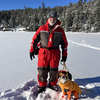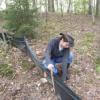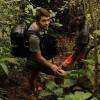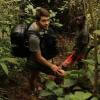In recent decades, the use of dogs in conservation work has exploded. Deployed to detect things like invasive or elusive species, scat, poachers, illegal wildlife trade products, and much more, conservation dog teams are trained to aid teams in the field. With benefits like speedier searches over large areas, proven targeted detection accuracy, and ease of transport and surveying, conservation dogs also offer possibilities for enhancing other technological methods by confirming or providing results in real-time.
Conservation dog teams now provide scat, reptile, aquatic species, whale scat, and invasive plant detection, and plenty more. This expansion of use is partly due to refined training techniques that offer a broader capability in very specialized detection roles, and partly due to more people seeing the capabilities and benefits of trained dogs.
Specifically, the utilization of dogs in conservation has experienced a considerable increase in recent years as people realize what the capability brings to the field survey arena. The benefits of dogs offering enhanced detection to support surveys includes:
- Speed of search
- Covering large areas effectively
- Proven detection capability
- Calibrated on a variety of species, if required
- Accuracy in the detection of targets and ignoring similar non-target specimens
- And easy to transport to survey sites.
Whether you train, handle, use, or are interested in finding out more about conservation dogs, this is the community for you! This group is growing, so if you'd like to get started and make connections here, here are some suggestions:
- Do you have advice to share with others who are interested in trying conservation dog work for the first time? Or do you need advice on whether conservation dogs suit your work?
- Do you have resources or research to share on training or using conservation dogs?
- Do you have a case study or project update that involves conservation dogs?
- Do you have a question about how to access conservation dogs for your own work?
Your group manager is Paul Bunker. Direct message him through WILDLABS or email him here with any questions or suggestions.
Header photo: Bill, photographed by Stephanie O'Donnell
No showcases have been added to this group yet.
- @Ziggy
- | She/Her
Aquatic biologist focused on aquatic invasive species and freshwater pearly mussels
- 0 Resources
- 0 Discussions
- 4 Groups
- @mattaudette
- | he, him, his
Software Tester and Test Automator at Wildlife Protection Solutions
- 0 Resources
- 1 Discussions
- 24 Groups
- @kricherds
- | she/her
Technologist. Civic Science Fellow & Data Inclusion Specialist at OEDP.

- 0 Resources
- 0 Discussions
- 14 Groups
- 0 Resources
- 0 Discussions
- 5 Groups
- @CitlalliMJ6
- | she/her
Conservation biologist, executive director at the Tesoro Escondido Reserve Foundation in the Ecuadorian Chocó, working on participatory action research, environmental education, primate and amphibian conservation
- 0 Resources
- 0 Discussions
- 7 Groups
St. Lawrence University
Professor of Biology at St. Lawrence University
- 0 Resources
- 2 Discussions
- 12 Groups
- 0 Resources
- 0 Discussions
- 16 Groups
World Wide Fund for Nature/ World Wildlife Fund (WWF)
- 0 Resources
- 7 Discussions
- 12 Groups
Botswana Predator Conservation Trust



- 0 Resources
- 85 Discussions
- 10 Groups
Dedicated wildlife conservationist with over three years of hands-on experience in field research and conservation. Through extensive fieldwork i developed a strong foundation in various conservation techniques, including camera trap deployment, plant inventory methods.
- 0 Resources
- 0 Discussions
- 9 Groups
- 0 Resources
- 0 Discussions
- 4 Groups
University of British Columbia
Postdoc at UBC, exploring how drones enhance wildlife conservation using thermal cameras & AI tools to refine monitoring of large mammal populations in Canada & compare these approaches to traditional methods.
- 0 Resources
- 0 Discussions
- 7 Groups
Scientists at Victoria's Healesville Sanctuary are using trained sniffer dogs on paddleboards to track and identify platypuses in their habitat.
23 July 2025
Murray-Darling carpet python populations in South Australia have declined due to loss of habitat and predation. Trials using conservation detection dogs to find the snakes in the Riverland have so far had positive...
26 May 2025
A published research study
15 January 2025
Their keen noses are helping researchers document the diversity of fungi living underneath Pacific Northwest forests.
15 January 2025
Published research paper
27 August 2024
WildLabs will soon launch a 'Funding and Finance' group. What would be your wish list for such a group? Would you be interested in co-managing or otherwise helping out?
5 June 2024
YouTube link to interview regarding the Saola Detection Canine project in Laos
10 December 2023
This article discusses a project utilizing canines to detect the scat of a critically endangered mammal, the Saola.
10 December 2023
A secure platform designed for those working to monitor & protect natural resources. Insight facilitates sharing experience, knowledge & tools to increase efficiency & effectiveness in conservation. By...
7 November 2023
Detection dogs may provide a non-invasive way to determine female receptivity, but this has not been explored in captive wildlife. This exploratory study investigated the use of detection dogs as a novel method of...
25 October 2023
By sniffing out egg masses, dogs are helping researchers against an invasive species
26 April 2023
Published paper attached
14 November 2022
December 2023
event
| Description | Activity | Replies | Groups | Updated |
|---|---|---|---|---|
| This paper describes the training methodology used to investigate the ability of a scent detection dog to locate live riverine rabbits (... |
|
Conservation Dogs | 3 years 10 months ago | |
| This class is being offered again, here's the information: Online DATES: December 27, 2021 - January 21, 2022 EARLY BIRD REGISTRATION ENDS NOVEMBER 10, 2021... |
|
Conservation Dogs | 3 years 10 months ago | |
| Please feel free to reach out if you have questions. |
|
Conservation Dogs | 3 years 11 months ago | |
| Dogs, in simple terms are a tool just like any other technology you use. There are advantages and limitations just like any other technologies. I like to tell people they need to... |
|
Conservation Dogs | 3 years 11 months ago | |
| Forget the newest technology: One of the most powerful tools in conservation research is human’s best friend. Rogue Detection Teams... |
|
Conservation Dogs | 3 years 11 months ago | |
| Professional, skilled, talented... team member Freya, a three-year-old Springer Spaniel carries out important work for us [Wessex Water... |
|
Conservation Dogs | 4 years ago | |
| With Murder Hornets being located on the west coast of the USA this research could offer some lessons learned: Three main... |
|
Conservation Dogs | 4 years 1 month ago | |
| Dear Chavoux, thank you for your reply, you perfectly summarize the challenges of this project. I will add another one: dog care, community in Congo are not used to... |
|
Conservation Dogs | 4 years 2 months ago | |
| At the seedling stage, invasive plants like Scotch broom are notoriously difficult for humans to spot. But dogs can locate hard-to-find... |
|
Conservation Dogs | 4 years 2 months ago | |
| Best Practices and Application to the Illegal Rhino Horn Trade - Includes an informative section on the use of dogs. "The following... |
|
Conservation Dogs | 4 years 2 months ago | |
| In this 40-minute video we: "Learn a little about what the conservation detection dog method is and how Rogue Detection Teams does it... |
|
Conservation Dogs | 4 years 3 months ago | |
| I just have to say that this is an absolutely brilliant title...bravo to those authors! :) |
|
Conservation Dogs | 4 years 4 months ago |





















